You would be less mixed up if you imagine the finished prop and work your way toward the details from there.
Let's say it's a 3-blade prop. All 3 must be identical. If you are facing a fully assembled windmill prop, then you can't see much of the alternator behind it, because the thick root of the blades cover most of it. Each blade (should) taper as you look at the tips. The face you are looking at is basicaly all flat planes. The wind is at your back, and the side of the blade you can see is the "bottom" of the airfoil. The other side of the blades has much more curvature - that is the "top" of the airfoil.
Walk around to look at the prop edge on. Now you can see the leading edge (blunt) and trailing edge (sharp). The blade inclines the leading edge slightly forward, but mostly it points in the direction of rotation. If the blade was made with any twist, then it will be obvious from here. The tip points almost exactly in the direction of rotation, but at the root the angle is more like 30 degrees.
Here's a graphic looking at the tip of a blade:

The wind blows from the top to the bottom of the diagram. Lift points down, and the blade moves to the left. The red line is a straight trailing edge, which works fine and I think that's how the Otherpower blades are made. The airfoils in the diagram were drawn with a "theoretical" ideal twist, which was part of some previous discussion long ago, so the trailing edge could be curved, if you want. Hopefully it serves the purpose of illustration.
Here's one of my blades after carving:
